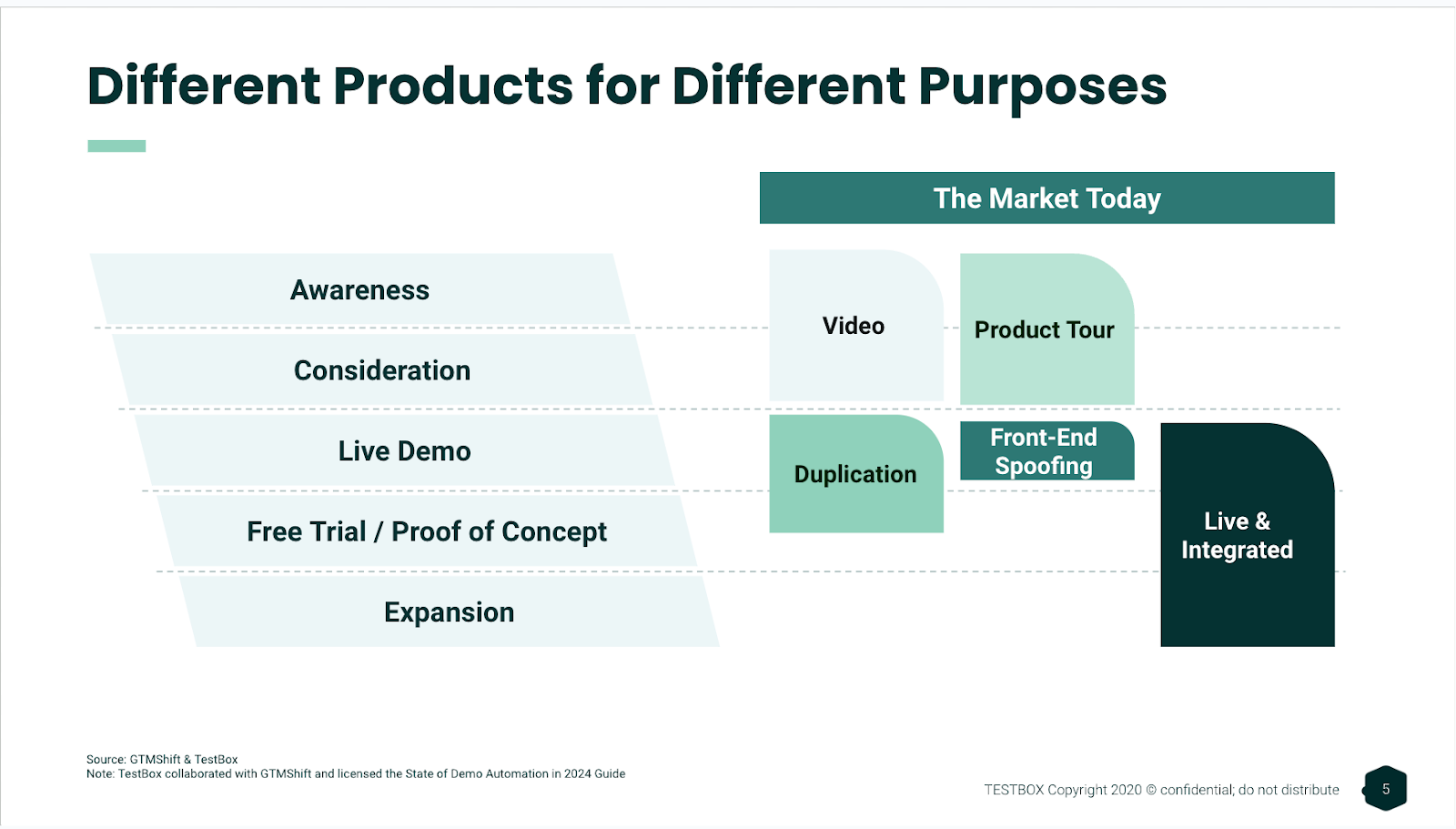What is Demo Software? [Plus Top Tech for Every Type of Software Demo]

CEO, Co-Founder
The rise of PLG has prompted an explosion of new tools and strategies designed to help customers get hands on with a product faster.
In fact, this area has grown so quickly that G2 dedicated an entirely new category to demo automation. Gartner is likely doing the same, stating that a potential new category is blooming with venture capitalists “circling around in the demo and product experience space.”
But most people don’t know what demo software is, the forms it takes, or how people use it in practice. So in this post, we’ll define demo software, outline the three main types of demo software, and technology suggestions for each type of demo.
What is product demo software
Demo software is a term given to any tools or solutions designed to help teams showcase their product to prospective buyers and end-users.
Simply put, it’s a suite of no-code tools that help teams deliver better software product demos.
Demo software can be used to automate high-level overviews of your product, which gives your team more time to focus on customizing and personalizing more extensive demos for the highest value accounts.
Types of software demos
There are four main types of demo software, and each has its own use case for a typical SaaS go-to-market strategy.

Below, we define each of them and share where they typically sit in the sales cycle:
1. Interactive demos or Product Tours
Interactive demos are lightweight clickable versions of your product that don’t require any coding or engineering to configure.
They showcase product capabilities and empower potential buyers to experience the product before they buy it. Plus, interactive demos can be edited and tailored specifically for each ICP, guiding prospects straight to aha moments that prompt conversion.
Interactive product demo software captures HTML/CSS data so it looks and feels like your actual product. HTML/ CSS captures can also be easily edited to fit demo requirements or blur out unfinished UI or messy product data. And because they’re no-code, any member of the GTM team can spin up a new one in just a few days.
Best for: Your website, sales leave-behinds, and in-app activation
2. Live demo software
Live demo software is what it sounds like — it helps sales reps or sales engineers demo a product live. They get a sandbox full of data that looks and feels like your real product, but they don’t have to worry about the UI looking off or features crashing.
Today, live demos typically take place over online meetings. Prospects watch and listen as the presenter shares their screen, pointing out various features depending on what issues a prospect is facing.
This setup is ideal for one-on-one sales meetings, particularly during upsell and expansion calls.
But it’s also tough to scale. Unlike an interactive demo, which users can access at any time, a live demo still requires a rep to guide them through it.
Best for: Live sales calls, sandbox creation
3. Video and screenshot demos
Videos and still shots of your product generate awareness among prospects and get them to consider your tool as a contender in their evaluation.
They can be reused in multiple sales conversations, marketing materials, or onboarding resources, and they can address a large audience.
At the same time, videos can’t be edited like HTML/CSS data, making it hard to clean up messy product data. Plus, they don’t give prospects the opportunity to get hands-on with your product. Not to mention, high-end product videos can be costly — they have to be updated with each new feature or UI release.
Best for: Blog posts, help centers
For a deeper dive into each of these types of demos, check our webinar with Testbox on Demo Automation.
Top Tech for Demo Software
Looking for new demo software? Here are some of the top tools on the market in each category:
Navattic
Type: Interactive Demo, Video + Screenshot
With a built-in no-code editor, Navattic makes it easy for anyone to design gold-standard interactive demos in minutes. We also offer on-demand demo reviews for all customers based on data from over 20,000 demos built on our platform to make sure their demos convert.
Our HTML/CSS demos can be used across the funnel, from first touch in outbound campaigns to website product demos to post-demo leave-behinds.
Besides integrations with Salesforce and HubSpot, we have integrations with G2, TrustRadius, Twilio Segment, Marketo Google Analytics, Mutiny, Chameleon, and more.
Price: We have two simple pricing plans at Navattic.
- Base: $500/mo for unlimited licenses, unlimited interactive demos, unlimited demo views, and unlimited integrations
- Growth: $1,000/mo for multi-team functionality, SSO and directory sync, multi-language support, a dedicated CSM, and demo coaching
Testbox
Type: Live Demo
Testbox is a platform that sits atop a live instance of your product. Since it’s not just a replica of your product, there are no limitations — complex features and AI models work as they normally would, and they’re always up to date.
You can even use AI to generate fake data, making workflows look more realistic to potential buyers.
After you send a TestBox demo environment, you can see which stakeholders have interacted with it the most and where they spent most of their time.
Users can spin up TestBox sandboxes from within the app or via CRM integration and personalize them to each prospect’s needs.
Price: TestBox starts at $100/user per month, paid annually. With this plan, you get unlimited live demos, unlimited POCs, PII-free custom data, a dedicated CSM, and Salesforce, HubSpot, Slack, and Marketo integrations.
Reprise
Type: Interactive Demo, Live Demo
Reprise has three separate demo products: Reveal, Replay, and Replicate. Reveal allows you to overlay and customize a live application, whereas Replay captures your full product to share with potential customers.
The most sophisticated of the three, Replicate, clones your application entirely, down to the code level.
Each of these products is sold separately. And while Reprise does not publicly share its pricing, our customers and prospects say the company uses a sliding-scale pricing model based on the number of demos and user seats.
Price: Contact sales.
Arcade
Type: Video + Screenshot
Arcade is a video and screenshot-driven demo software tool. Users install the Arcade Chrome extension and start capturing clips from their browser. For an extra cost, users can edit video and audio straight from the platform.
Because Arcade is one of the more affordable options, it lacks HTML/CSS cloning capabilities like interactive demo tools have, making it better suited for simple products and short tours.
Price: Arcade has 3 cost tiers:
- Pro: $32/mo for 1 user, unlimited Arcades, video editing, GIF export, Intercom support.
- Growth: $42.50/month per user. This plan includes white-labeled Arcades, custom themes, insights, and advanced branching features.
- Enterprise: Custom monthly price for enterprise teams.
Consensus
Type: Video + Screenshot
With Consensus, you can build customized videos for specific prospects or customers.
This is great for companies that already have a good amount of video and want to tailor shorter clips for different segments of their audience — getting straight to the heart of what the viewer cares about.
You can also build questionnaires into Consensus to direct prospects to videos that best fit their needs or use cases.
Although these videos feel highly personalized, they aren’t entirely self-serve. Users don’t get to interact with your product themselves, leaving them with open questions that need to be answered on a sales call.
Price: Contact sales. According to their pricing page, cost depends on role and license quantity.
Demo software can save your sales team time, educate leads, and, most importantly, get prospects excited about purchasing and using your product. If you’re interested in learning more about presales software and how it might work for you, consider reading: